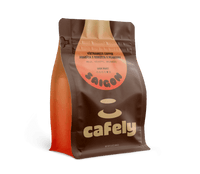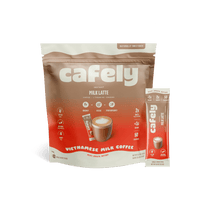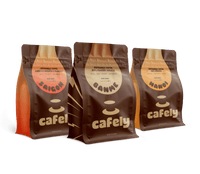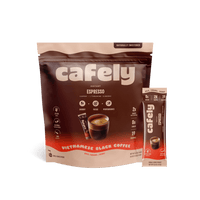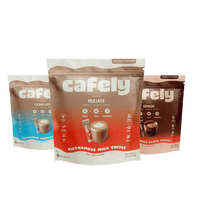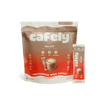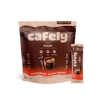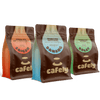The formula for a good pot of coffee is simple — use fresh, high-quality, whole-bean coffee, filtered water, and clean, unbleached filters. As long as your ingredients are fresh and your equipment is up to the task, making a pot of drip coffee that's as good as your local café or coffee shop is easy.
With that said, it's important to follow a few simple steps closely for the most effective extraction.
In this read, you'll learn how to make a good pot of coffee with a regular coffee maker and a few ways to elevate the brew like a barista…
Brewing Specs
- Brew Time: 5-10 minutes (varies by model)
- Coffee-to-Water Ratio: 1:16
- Grind Size: Medium
- Water Temperature: 195–205°F (90–96°C)
- Recommended Coffee: DaLat 100% Arabica Coffee
Brewing Summary
- Select a high-quality, whole-bean coffee.
- Measure and grind the coffee to a medium consistency.
- Pre-rinse the filter and preheat the machine.
- Bloom the coffee.
- Brew the coffee.
- Adjust and serve.
What You Need

You don't need much in terms of ingredients or equipment to make a good pot of coffee with a drip coffee maker. However, the quality of the ingredients you use is extremely important.
Here's what you need to make a good pot of coffee:
Equipment
- Drip Coffee Maker — These come in a range of shapes and sizes from a variety of brands, but they all work in a similar way. A machine with a glass carafe is best — plastic and certain metal pots can taint the taste of the coffee.
- Coffee Grinder — If you want to make a good pot of coffee, you must use whole beans. To grind these beans consistently before brewing, use a burr grinder.
- Coffee Filters — Use unbleached paper coffee filters or an eco-friendly cloth alternative.
Ingredients
- High-Quality Coffee — Use a high-quality whole-bean coffee with a recent roast date. We recommend a dark roast 100% arabica such as DaLat.
- Water — Use fresh, filtered water. This produces the cleanest brew and protects your machine from mineral buildup.
- Sugar or Syrup (optional) — Add sugar or your favorite coffee syrup to add sweetness and flavor.
- Milk or Creamer (optional) — Add a dash of milk or coffee creamer to mellow out the bold, dark flavors of your coffee.
Coffee Recommendations
A great pot of coffee starts with quality beans — always grind them fresh just before brewing for the best flavor and aroma.
For drip coffee, medium or dark roasts work best, giving you a nutty, caramel-like richness. You’ll usually be choosing between three options:
- 100% Arabica — Smooth, naturally sweet, and balanced. Ideal if you want complexity without bitterness. Try Cafely's DaLat arabica.
- 100% Robusta — Strong, bitter, and high in caffeine. Better for espresso than drip, though Cafely’s BanMe Coffee showcases robusta at its boldest.
- Blends (Arabica + Robusta) — Fuller-bodied with more intensity and bitterness. Saigon OG, for example, is darker and stronger, perfect if you like a punchier brew.
If you prefer nuance and sweetness, stick with arabica. If you like intensity, try a blend.
Step-By-Step Guide: Making a Good Pot of Coffee
Making a pot of coffee with a drip coffee machine is simple, but a few key steps can transform your pot from average to excellent.
Follow these steps to make a delicious pot of drip coffee:
1. Measure and Grind the Coffee
First, you need to measure and grind your coffee. For making drip coffee, a medium grind is required — similar in consistency to table salt. A burr grinder is the best option for achieving a consistent, even grind.
The amount of coffee you need to prepare depends on how much coffee you wish to brew.
Use the chart below to work out how much coffee and water you need:
|
Servings |
Coffee |
Water |
|
1–2 Servings |
4 tbsp (28 grams) |
2 cups (470 mL) |
|
3–4 Servings |
8 tbsp (56 grams) |
4 cups (950 mL) |
|
5–6 Servings |
12 tbsp (84 grams) |
6 cups (1.4 L) |
|
7–8 Servings |
16 tbsp (112 grams) |
8 cups (1.9 L) |
|
9–10 Servings |
20 tbsp (140 grams) |
10 cups (2.2 L) |
|
11–12 Servings |
24 tbsp (168 grams) |
12 cups (2.8 L) |
2. Prepare the Coffee Machine
Fill the reservoir of your drip coffee maker with cold, fresh, filtered water. Add one to two cups more than you need. Make sure the machine is free from spent grounds and residues — regular cleaning prevents the buildup of oils and minerals.
Place a paper (or cloth) coffee filter inside the filter basket. Place the carafe on the drip tray below the basket.
3. Preheat the Carafe & Pre-Rinse the Filter
This step is essential if you want to brew a “better than ordinary” pot of coffee.
Run your machine without any grounds in the basket and allow one to two cups of hot water to pass through the filter into the carafe below. Then, turn off the machine, swirl the hot water around the carafe, and discard.
This process has two actions — it rinses the filter, ridding it of impurities, and pre-heats the carafe.
Note: Double-check the water level of the reservoir after this step and top it up if needed.
4. Bloom the Coffee Grounds
This is another step that improves the quality of your brew.
Place the ground coffee in the filter basket and spread it evenly.
Then, pour a small amount of hot water over the grounds so they’re just about saturated. Wait for 30 to 60 seconds. Some drip coffee makers may have a bloom function; if yours does, use it instead.
This process “blooms” the coffee grounds, releasing trapped gas. This results in a more even extraction.
5. Brew the Coffee
Once the coffee has bloomed, turn the machine on and brew the coffee. This can take anywhere from five to 15 minutes, depending on your machine and how much coffee you’re brewing.
6. Serve and Adjust to Taste
Once your machine has finished brewing, remove the carafe and pour yourself a cup. Your brew should taste smooth, rich, and have a clean finish. Enjoy your coffee black or add sugar, syrup, and/or coffee creamer to taste.
Tips For Making a Good Pot of Coffee

Making a good pot of drip coffee is simple, doesn’t require expensive tools or barista-level skills, but it does benefit from a few additional steps.
These simple adjustments can elevate your everyday coffee from average to exceptional.
Follow these tips to make sure your coffee is perfect every time:
1. Use High-Quality Quality Coffee
The quality of your coffee beans makes the single biggest difference in how your brew tastes.
Avoid low-grade supermarket blends with unclear sourcing or vague descriptions like “100% coffee” or “dark roast.” Instead, opt for beans from specialty brands that are freshly roasted and highlight origin, flavor notes, and roasting processes.
We recommend using 100% arabica coffee for making a good pot of drip coffee that’s just as delicious black as it is creamed.
Our DaLat arabica beans are the perfect candidates, but high-quality arabica beans are available elsewhere.
Just make sure to do your research and buy as fresh and as high-quality as possible.
2. Always Use Whole-Bean Coffee
Coffee is sensitive once roasted. When exposed to air, coffee begins to lose its flavors and aromas rapidly due to oxidation.
Coffee begins to lose its flavor within minutes of being ground. However, whole beans retain their flavor and aroma much longer. For this reason, it’s far better to use whole-bean coffee — you’ll produce a far tastier pot of coffee by grinding coffee just before brewing.
Use a burr grinder for the most consistent grind size — uneven grinding from blade grinders can lead to under- or over-extraction, which can make your coffee taste overly bitter or sour.
3. Use Fresh, Filtered Water
Since a pot of coffee is more than 98% water, using poor-quality water will result in poor-tasting coffee. Unfiltered tap water contains chlorine, minerals, and impurities that can dull and distort the flavor of your coffee.
Use bottled or filtered water that’s fresh, clean, and free from minerals. This will not only make your coffee taste better, but it will also increase the life of your machine.
4. Pre-Wet Your Coffee Filter
If you're using a paper filter, always rinse it with hot water before adding the grounds.
This simple step has a few main benefits:
- Removes impurities from the filter that can taint the taste of the coffee.
- Warms the filter basket and carafe, helping to maintain optimal brewing temperature during extraction.
- Allows the grounds to sit more evenly in the filter basket, improving saturation and extraction.
5. Always Bloom the Coffee First
Blooming is an essential step if you wish to produce the best possible pot of drip coffee. Freshly ground coffee releases carbon dioxide (CO2) when hot water is added to it.
Blooming — the action of adding a small amount of hot water to the grounds first — releases the CO2 before brewing. If you skip this step, the CO2 can repel water, leaving some of the grounds less saturated than others, resulting in an uneven extraction.
To bloom the coffee, pour just enough hot (not boiling) water over the coffee grounds to saturate them. Let them sit for 30 to 60 seconds to allow time for the gases to escape, then start the brewing cycle.
6. Adjust the Coffee-to-Water Ratio
If you’ve made a pot of coffee using the exact steps above and it still doesn’t taste good, it may be down to your taste. Getting the right coffee-to-water ratio for your taste is essential.
If you find your brew too strong, reduce the coffee-to-water ratio. If it’s too weak, increase the coffee-to-water ratio. Do this incrementally (using half a tablespoon at a time) until you find the perfect ratio for your palette.
Improving the Flavor of Your Coffee With 4 Simple Ingredients
Even if your pot of coffee doesn't taste as good as expected, there are a few ways to improve its flavor. If your coffee beans are starting to stale or your coffee isn't particularly high in quality, some simple additions can elevate its flavor.
Here are four ways to improve the taste of your coffee:
1. Add a Pinch of Salt
This may sound surprising, but adding a pinch of salt to your coffee can neutralize bitterness and bring out the natural sweet flavors of coffee. However, adding too much can have the opposite effect, so it must be used cautiously.
Add a small amount (less than 1/8th of a teaspoon) per serving to your grounds before brewing. This minor change can improve the flavor of all but the worst quality coffee.
2. Add Coffee Syrup
Coffee syrup is available in a range of flavors — essence of vanilla, caramel, hazelnut, mocha, seasonal blends, and more. A splash of syrup can mask unwanted bitterness or slightly stale flavors of older beans and add a layer of sweetness to your brew.
Coffee syrup is especially useful if you want to create coffee house-style brews in the comfort of your home.
3. Add Coffee Creamer
Creamers — whether dairy or plant-based, flavored or unflavored, store-bought or homemade creamer version — can dramatically alter the taste and body of your coffee.
They cut bitterness, add creaminess, and “fill out” the clean body of drip coffee. Adding a small amount of creamer (one to three tablespoons per cup) can complement the natural flavors of coffee and elevate the taste of the brew.
However, adding too much can completely cover up the taste of the coffee, so use it sparingly, especially if the syrup is sweetened and flavored.
4. Make Iced Coffee
Did you know you can make iced coffee with drip coffee? In fact, if your beans are a little past their use-by date, making iced coffee is one of the best things to do with them.
Chilling the brew and adding milk and syrup can cover up bitter, stale, or sour notes and bring out the more nuanced flavors of the coffee — even if it's getting a little old.
To make iced coffee, brew a strong pot of drip coffee and cool it. Pour the brew over ice, add your favorite coffee syrup, and dilute at a 50:50 ratio with milk. Serve in a tall glass and enjoy.
FAQs: Making a Good Pot of Coffee

Want to learn more about making great-tasting coffee?
Check out the answers to some of our most frequently asked questions below, or head over to the Cafely Blog.
1. What's the Best Coffee for Making Drip Coffee?
Medium to dark roast arabica beans or a well-balanced blend are the best choices for making drip coffee. They offer a balanced flavor profile that’s neither too bitter nor too acidic when brewed with this method. Make sure to opt for high-quality coffee and, if possible, grind whole beans yourself — this will result in the best-tasting brew.
2. Is Whole-Bean Better Than Pre-Ground Coffee?
Yes. Whole-bean coffee retains its freshness, flavor, and aroma far longer than pre-ground coffee. Grinding freshly-roasted whole beans just before brewing ensures a more flavorful and aromatic cup than using store-bought ground coffee.
3. What's the Difference Between Arabica and Robusta Coffee?
Arabica and robusta are two different species of the coffee plant (Coffea). Arabica beans are smoother, sweeter, and have more complex flavor notes. Arabica is often used to make a variety of Italian, espresso-based beverages.
Robusta beans are bolder, darker, and more bitter. They contain around twice the amount of caffeine and are generally used to make Southeast Asian brews such as Vietnamese coffee.
4. What Grind Size Should I Use for Making Drip Coffee?
Use a medium grind — similar in texture to table salt or sand. This allows for optimal extraction in drip and pour-over brewers — preventing weak under-extracted coffee or bitter over-extracted coffee.
5. How Long Does a Pot of Coffee Stay Fresh After Brewing?
A pot of drip coffee is best enjoyed within 30 to 60 minutes after brewing. Your pot of coffee can sit on a hot plate for a few hours, but the flavor will degrade quite quickly after brewing due to oxidation.
6. Can You Reheat Coffee?
Yes. You can reheat leftover coffee. However, it's not ideal. Reheating coffee — especially with a microwave — can make it taste stale and bitter. If you must reheat coffee, gently warm it in a stovetop pan, being cautious of overheating.
7. Is French Press Coffee Better Than Drip Coffee?
Whether French press is better than drip coffee depends on your preference. French press coffee tends to be richer and fuller-bodied with a slightly silty mouth-feel, while drip coffee is cleaner, thinner, and more consistent. There’s no harm in trying both to see which one suits you best.
8. What's the Difference Between Pour-Over and Drip Coffee?
Pour-over and drip coffee are two different brewing methods that work on the same principle — pouring hot water over coffee grounds for extraction. The difference is, pour-over is manual (you have to pour the water over the grounds yourself), and drip coffee machines are automatic.
Pour-over brewing provides more control over water flow and extraction, which can result in a better cup of coffee, while drip coffee makers offer consistent results.
9. Can You Make Espresso Without an Espresso Machine?
Not exactly. A “true” espresso requires high-pressure brewing using an espresso machine. However, you can make a strong espresso-like beverage using an Aeropress brewer, moka pot, or Rok espresso maker. You can also purchase an instant espresso blend, which produces a similar shot without the hassle of brewing.
10. How Can I Improve the Taste of Bad Coffee?
While using fresh, high-quality coffee is important, you can make a reasonable cup of coffee with bad coffee. Make sure to use filtered water and the correct ratios for your brewing method. You can also mask stale, bitter, or sour notes by sweetening with syrup and adding milk or creamer.
